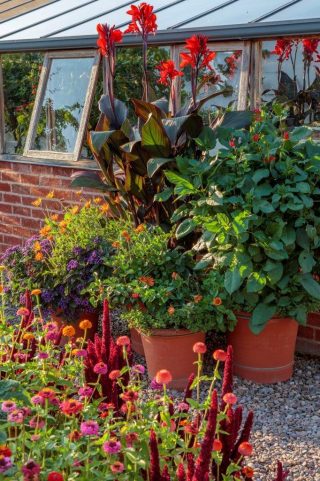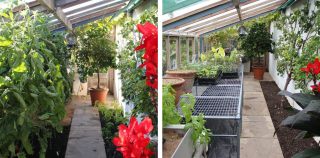It’s getting cold outside
If we cast our minds back to those long, warm summer days of July and August, the borders around the Kitchen Garden were alive with vibrant colour and textures. As we look around the Kitchen Garden the colour subtly changes from warm purples and yellows on the sunrise side of the Kitchen Garden to the dusky, burnt oranges and reds on the sunset border.


The ornamental borders around the Kitchen Garden could be described
as mixed borders, combining shrubs, herbaceous perennials, climbers on
the walls and, of course, our rose and clematis combinations grown
together. In the gaps between this permanent planting, the display is
augmented by thousands of tulips in the spring and in the summer their
place is taken by tender perennials including several different tender
pink and purple Salvia cultivars including Salvia ‘Nachtvlinder’ and S.
‘Neon’ as well as dusky red Chocolate Cosmos (Cosmos atrosanguineus).
Our vibrant pot display in the Kitchen Garden also incorporates many
tender perennials including Salvia ‘Royal Bumble’, Dahlia ‘New Baby’ and
dark-leaved Canna. These add colour and texture to the borders and help
to carry the colour in the display into the late summer and autumn.

However, being tender plants means that these plants won’t survive outside in the colder winter months. We therefore must lift the plants from the borders, and we employ a couple of different tactics to overwinter them and get them safely back into the borders for the following summer.
Dahlias are tuberous perennials and once their top growth has been scorched by the first frost of the autumn, we lift them from our pot display, cut them back, knock off all the compost from their tubers and turn them upside down in a crate lined with newspaper. Turning the tuber upside down helps to drain out any excess water and prevent it from rotting. The trays are then labelled and placed in a cool, dark, frost-free area until the early spring when they are potted up and grown on in the greenhouse. At this point, softwood tip cuttings can be taken from the emerging shoots and potted on for flowering in the following summer.
Much like Dahlias, Cannas also grow from an underground storage organ, but instead of tubers, Cannas have rhizomes. We treat our large plants in much the same way as the Dahlias by lifting them in the autumn and storing them in a frost-free place over the winter. However smaller plants can be potted up and grown in pots in a frost-free greenhouse over winter.
Chocolate Cosmos are also tuberous tender perennials, but we store these in a slightly different way to the Dahlias. Plants are lifted from the borders in autumn and cut back before being potted on into a crate filled with a free draining mix of multipurpose compost and perlite. The crate has been placed in the warm greenhouse and will be kept dry until the days start to get longer in the spring when we will gradually increase the watering to bring them into growth before potting them up and growing them on ready to be planted out in the borders in late May.
Finally, there are the Salvias. From August until October we were busy taking softwood cuttings which we have grown on and potted up in our heated greenhouse. These will be kept growing during the winter before potting them up in the spring so that they will be large plants ready to go in the borders in late May. When taking cuttings (see also August 2018), it is important that healthy, vigorous and pest and disease free material is taken from the mother plant and this should ideally be from a non-flowering side shoot for successful results. We have converted the greenhouse from the tomato beds of the summer by adding benching to allow us space to grow the tender perennials through the winter and our seed sowing in the spring.

We have also taken cuttings from a number of different tender, short lived and half-hardy perennials in the garden to overwinter in the greenhouse including Arctotis ‘Flame’ and Heliotrope ‘Midnight Sky’ from the Kitchen Garden pot display, Penstemons from the South Garden and Gaura ‘Whirling Butterflies’ and Erysimum ‘Bowle’s Mauve’ from the West Garden.
We are very excited about some new editions to our tender perennial display for 2022 including lemon-yellow Salvias and a new tropically vibrant Canna! We hope that the tender perennials will be kept warm through the cold winter months and as they emerge from the greenhouse, we look forward to sharing these vibrant and colourful additions to the borders with our garden visitors in 2022.
